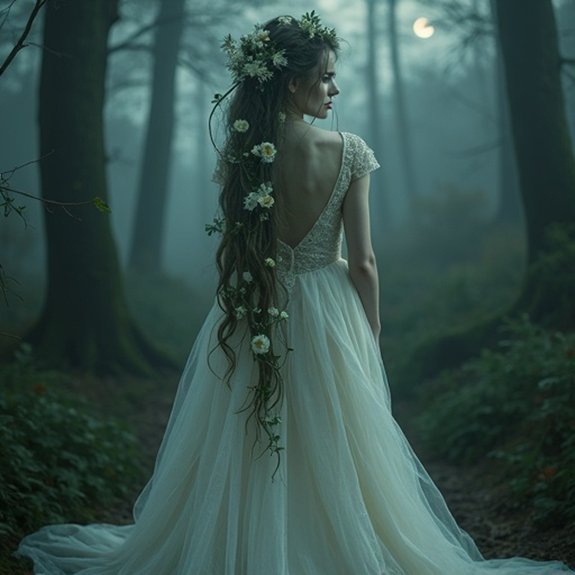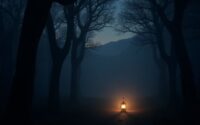The Monster Bride / Bride in Folklore
Throughout history, cultures worldwide have whispered tales of monstrous brides who’ve seduced, terrified, and transformed their unsuspecting partners. These supernatural beings blur the line between desire and danger, appearing as beautiful women who harbor dark secrets beneath their alluring facades. From ancient Greek myths to Japanese folklore, they’ve served as warnings about the unknown forces that lurk within intimate relationships. But what’s driven humanity’s enduring fascination with these deadly matrimonial figures?
Introduction

When tales of supernatural unions echo through centuries of human storytelling, the monster bride emerges as one of folklore’s most enduring and complex figures. She’s appeared across cultures as the shape-shifting fox spirit, the serpent woman who sheds her scales, and the corpse bride who returns from death seeking love. These narratives explore humanity’s deepest anxieties about marriage, otherness, and transformation.
The monster bride archetype serves multiple functions in folklore. She tests heroes’ compassion, challenges social boundaries, and embodies the fear of deception within intimate relationships. Sometimes she’s a victim of circumstance, cursed until true love breaks her spell. Other times, she’s a predator who lures unsuspecting mortals to their doom. Her dual nature reflects society’s conflicting views about female power and sexuality.
Ancient Greek Lamia Myths
Although ancient Greek mythology contains numerous monstrous figures, Lamia stands out as the archetypal monster bride whose tragic transformation shaped centuries of folklore. Originally a beautiful queen of Libya, she became Zeus’s lover and bore his children. Hera’s jealous rage destroyed everything—she murdered Lamia’s offspring and cursed her with insomnia, forcing her to witness endless horrors.
The transformation didn’t stop there. Lamia morphed into a child-devouring monster with a serpent’s lower body. She’d seduce young men with her beauty’s remnants before revealing her true form and consuming them. Some versions describe her ability to remove her eyes, while others emphasize her shape-shifting powers. Her name became synonymous with vampiric seductresses throughout Greek literature, warning against deceptive beauty and divine vengeance’s cruel nature.
Notable Cases or Sightings

While most monster bride accounts remain confined to mythology, several documented encounters have captured public attention throughout history. In 1767, French nobleman Antoine de Beaumont claimed he’d married a woman who transformed into a serpent-like creature during their wedding night in Gévaudan. Local priests recorded his testimony before he vanished mysteriously.
Japan’s Meiji era produced multiple reports of “snow brides” who’d appear during blizzards, marry unsuspecting men, then reveal their yokai nature. The 1889 Niigata incident involved farmer Takeshi Yamamoto, whose bride reportedly dissolved into mist after three months of marriage.
More recently, Mexico’s 1952 “La Novia de Tlaxcala” case gained notoriety when witnesses described a bride whose face morphed into a skull during her ceremony. Police investigations found no trace of the woman afterward.
Common Theories or Explanations
Since ancient times, scholars have proposed various theories to explain the persistent monster bride phenomenon across cultures. Anthropologists suggest these tales serve as cautionary warnings about marrying outsiders or breaking social taboos. The stories often encode anxieties about female sexuality and men’s fear of women’s hidden nature.
Psychologists interpret monster brides as projections of the unconscious mind’s shadow aspects. Jung’s followers see them as anima figures representing the dangerous feminine archetype that men must integrate. Folklorists argue they’re metaphors for the transformation marriage brings—the “death” of single life and rebirth into partnership.
Some researchers propose historical origins: memories of encounters between different ethnic groups, diseases that caused disfigurement, or rare genetic conditions. Others view them as allegories for domestic violence or women’s rage against patriarchal oppression.
Frequently Asked Questions
How Do Monster Bride Stories Differ Across Asian, African, and Native American Cultures?
Asian cultures often portray monster brides as shape-shifting foxes or snakes seeking redemption through love. African traditions feature water spirits who’ll grant prosperity but demand loyalty. Native American stories emphasize transformation, where animal brides bridge natural and human worlds.
What Protective Rituals or Charms Were Traditionally Used Against Monster Brides?
Communities traditionally protected themselves from monster brides using iron objects, salt circles, and religious symbols. They’d place mirrors facing doorways, burn specific herbs like sage, and wear protective amulets containing verses or blessed items during wedding ceremonies.
Are There Male Equivalents to Monster Bride Figures in Folklore?
Yes, folklore features male counterparts like the Bluebeard figure who murders wives, vampire grooms, selkie husbands who steal their seal skins back, and demon lovers who seduce women. They’re equally deceptive and dangerous supernatural suitors.
How Have Monster Bride Myths Influenced Modern Horror Literature and Films?
Monster bride myths’ve shaped modern horror through vengeful ghost brides in Asian cinema, vampire brides in Gothic fiction, and zombie brides in comedic horror. They’ve inspired films like “Corpse Bride” and “Ready or Not.”
What Psychological Archetypes Do Monster Brides Represent in Jungian Analysis?
Monster brides embody Jung’s shadow feminine and the anima’s dark aspects. They’re manifestations of the terrible mother archetype, representing men’s unconscious fears of feminine power, sexuality, and transformation. They symbolize the devouring, castrating feminine principle.


